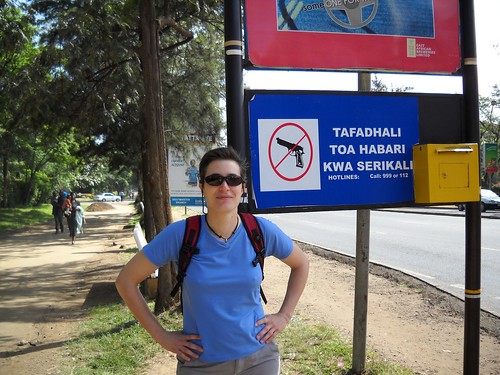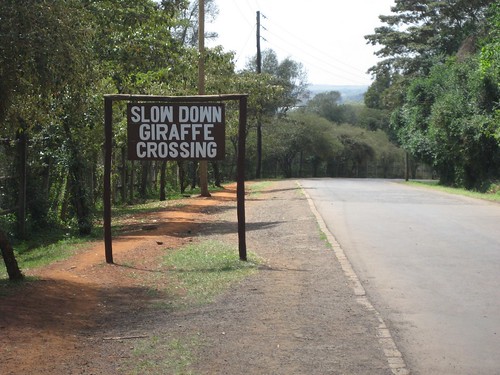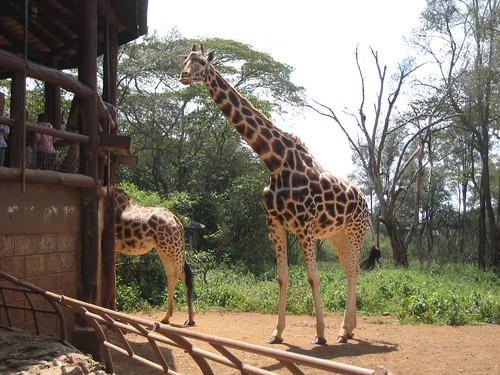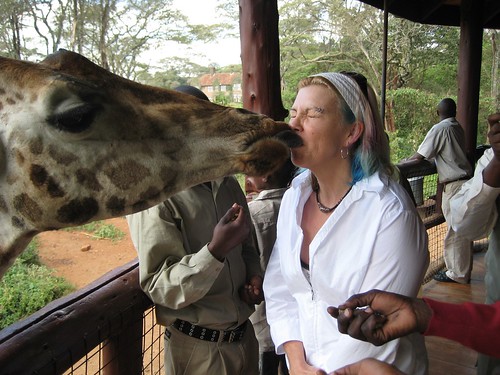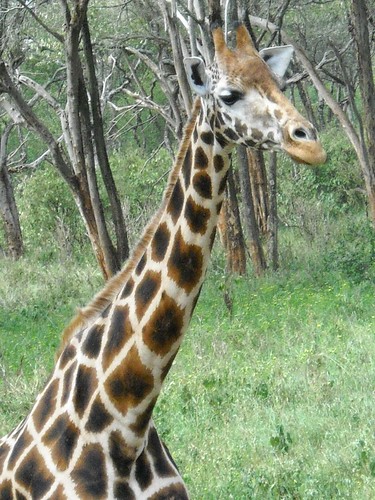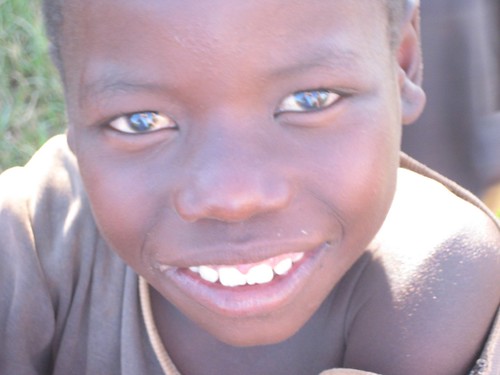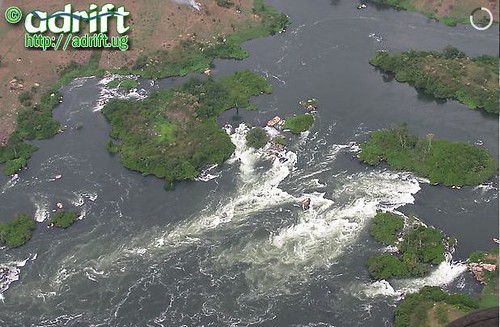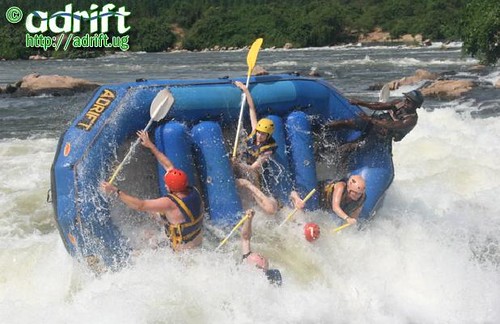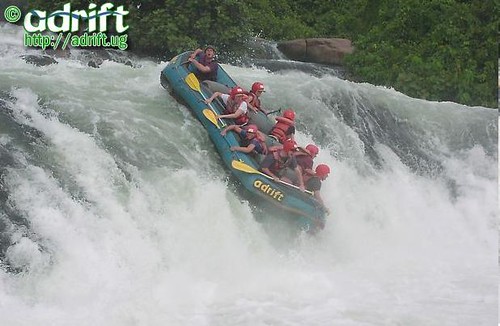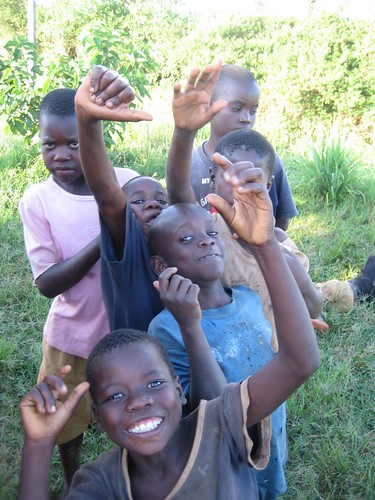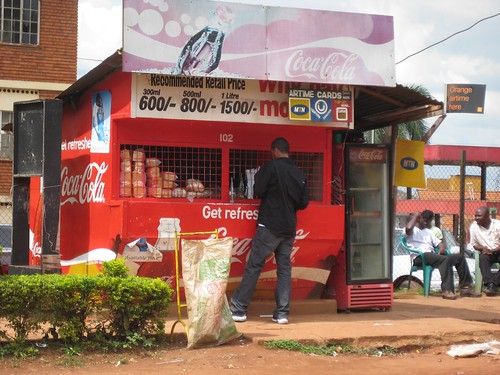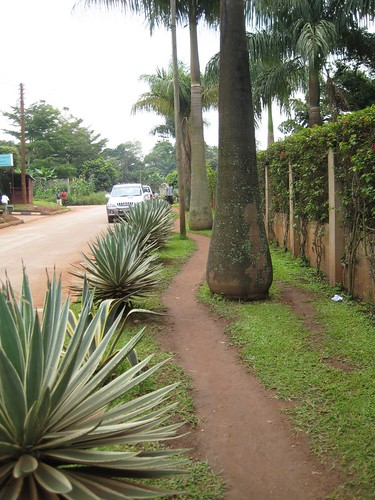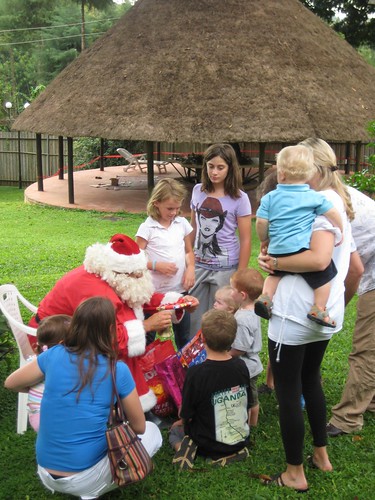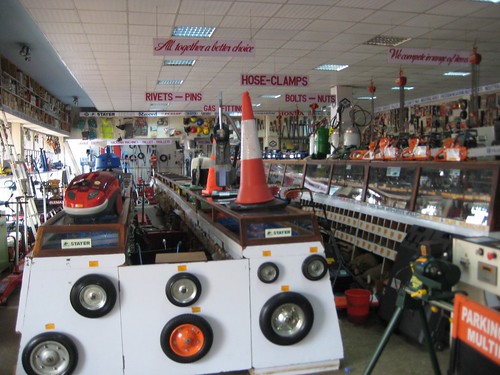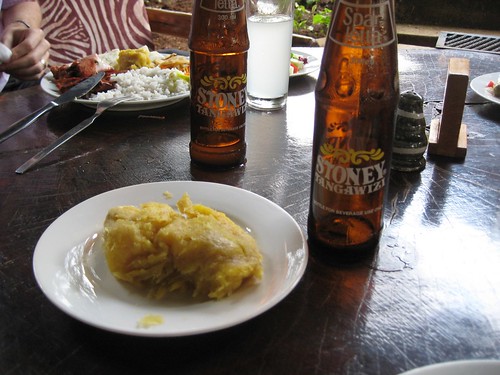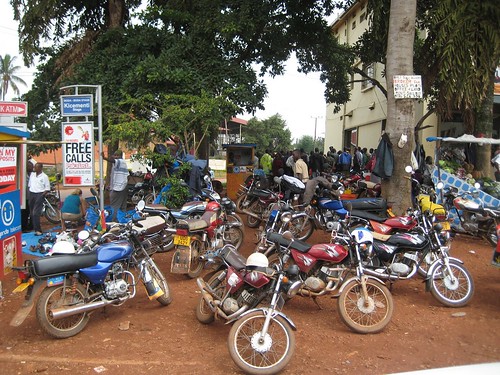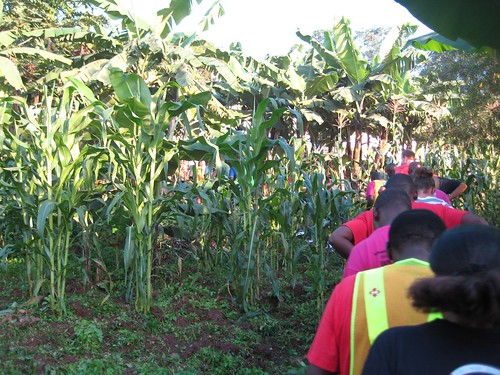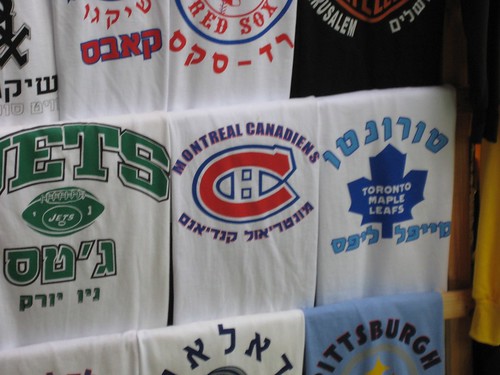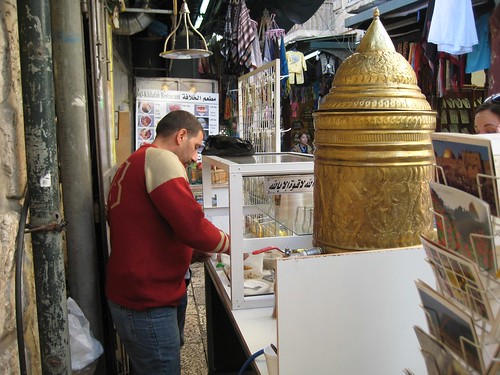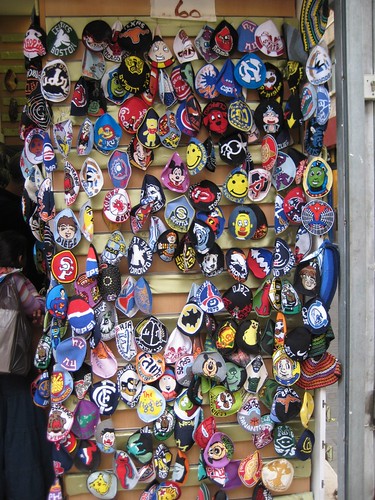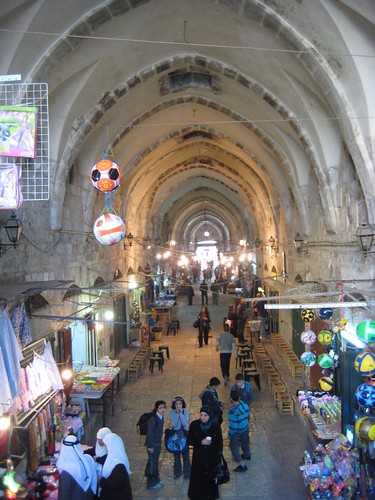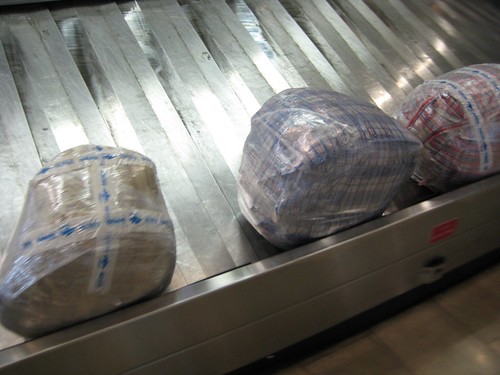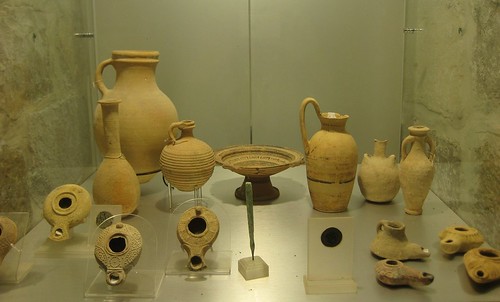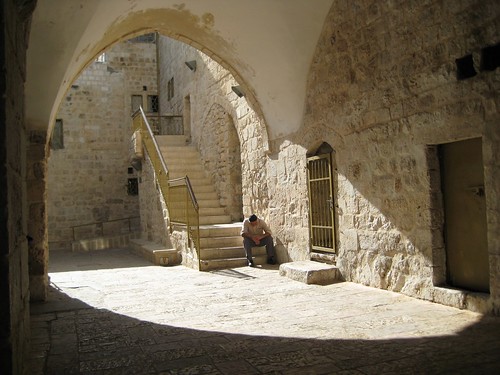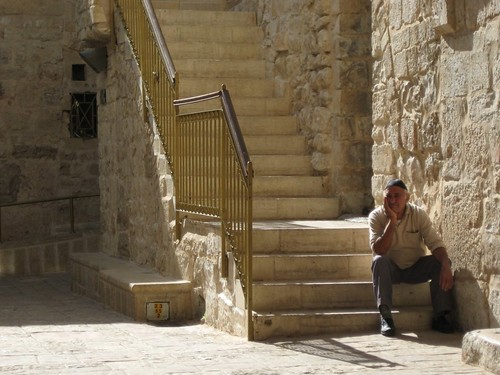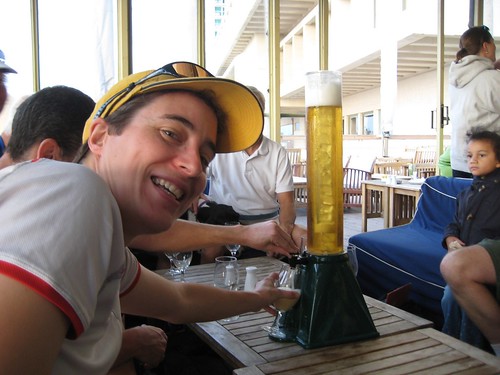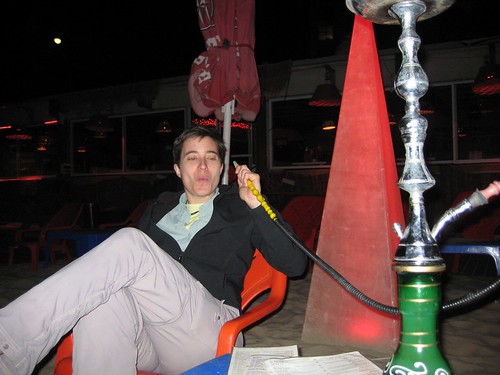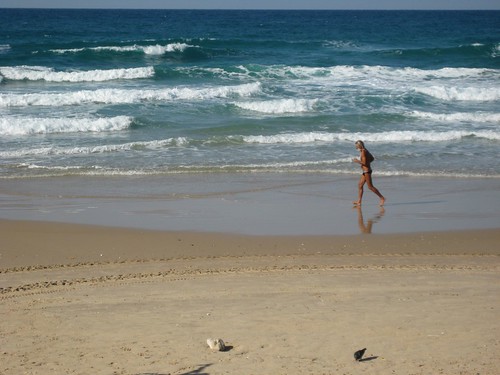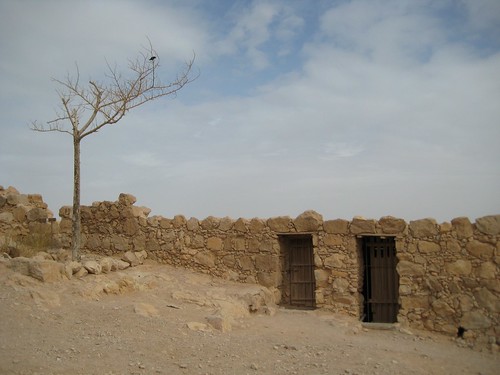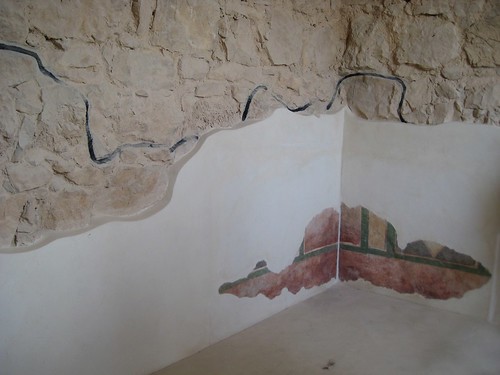I alluded to it earlier, but I’m now on an organized group tour with a company called Dragoman. There are 20 people in the group along with our leaders Sarah and Dave, and Charles the all-important cook. Our home is an enormous diesel truck (apparently a converted cement truck) called “Christie”. The truck carries all our personal crap, tents, sleeping mats, food, kitchen gear, folding chairs, beer, maps, books, and 23 increasingly grubby people.
The day after the village walk with the banana beer pitstop we abandoned the truck, pared down our gear, and split up into 5 small jeeps to carry us into Serengeti National Park for two days of game driving. (And here I’ll admit that I really didn’t have a clear idea of what “game driving” is, but it turns out it’s exactly what it sounds like – driving around all day, looking at game.) The jeeps are equipped with pop-off roofs, so you can stand up and have a 360 degree view.
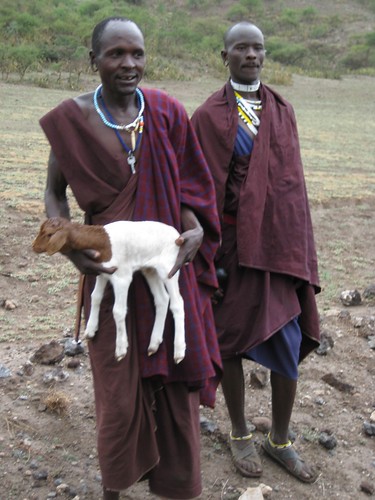 A pair of Maasai who were herding their goats alongside the road as we passed. We stopped to take their picture, for which we were charged 1,000 Tanzanian shillings each (about 80 cents). They really know how to work the tourists, the Maasai, though you can’t really blame them. They can be found wherever tourists gather, pushing necklaces and blankets and spears and even pairs of the odd sandals they wear which are made out of chunks of old tires with inner tube straps.
A pair of Maasai who were herding their goats alongside the road as we passed. We stopped to take their picture, for which we were charged 1,000 Tanzanian shillings each (about 80 cents). They really know how to work the tourists, the Maasai, though you can’t really blame them. They can be found wherever tourists gather, pushing necklaces and blankets and spears and even pairs of the odd sandals they wear which are made out of chunks of old tires with inner tube straps.
Our jeep driver (hose name was, I’m not kidding, Honest) was really good at spotting the game. We’d be bumping along the corrugated roads and he’d stop and say, “See the hyena!” and we’d all peer vainly and break out the binoculars, and sure enough, there would be a hyena poking its head out. It was like the guy had laser vision or something.
 Honest, with the laser eyes, sporting a traditional Maasai blanket
Honest, with the laser eyes, sporting a traditional Maasai blanket
But on to the game – we saw: baboons, antelope, lions, leopard, warthogs, giraffes, elephants, zebras, wildebeest, gazelles, monkeys, hippos, buffalo and rhinos. Some were breathtakingly close (a giraffe walked across the road between two of our jeeps) and some were binocluars-only. I took loads of photos, though in many cases there was little point because the animals were too far away to appear as anything other than an indistinct smudge to my tiny pocket camera. Luckily there are some serious photographers in our group with serious cameras and mega-zoom lenses and talk of f-stops and ISO settings and opto-graf filtration and things, and I’m sure they’ll be sharing once they get a chance.) Until then, check out these pics:
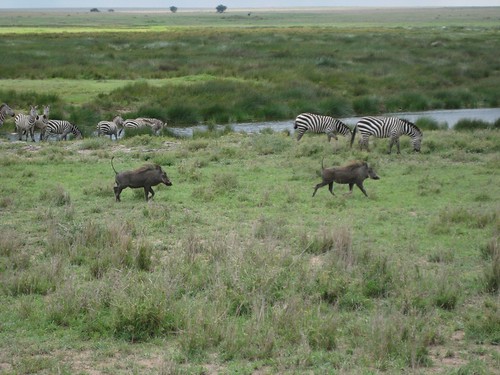 Zebras and warthogs – one of the coolest things about being out in the natural habitat is that you see the animals all mixed up together. Sometimes you could do a full turn and see zebras, giraffes, elephants, gazelles, wildebeest and warthogs all just hanging out.
Zebras and warthogs – one of the coolest things about being out in the natural habitat is that you see the animals all mixed up together. Sometimes you could do a full turn and see zebras, giraffes, elephants, gazelles, wildebeest and warthogs all just hanging out.  A giraffe munching on a thorny tree. I don’t know how they do it – those trees are completely covered in thorns two inches long. They look just vicious. (The trees, not the giraffes, who look quite lovely, as you’ve already seen.)
A giraffe munching on a thorny tree. I don’t know how they do it – those trees are completely covered in thorns two inches long. They look just vicious. (The trees, not the giraffes, who look quite lovely, as you’ve already seen.)
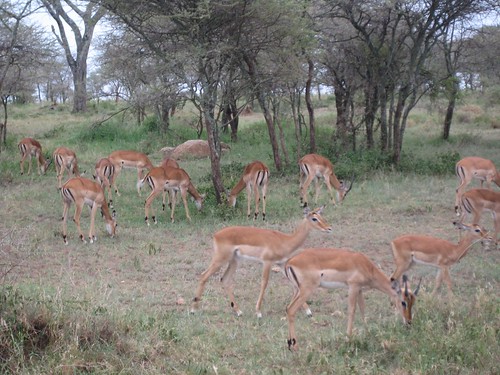 Thompson gazelles, there are zillions of these. So many (and so many zebras and wildebeest) that our jeep quickly instituted a “We don’t stop for ungulates” policy.
Thompson gazelles, there are zillions of these. So many (and so many zebras and wildebeest) that our jeep quickly instituted a “We don’t stop for ungulates” policy.
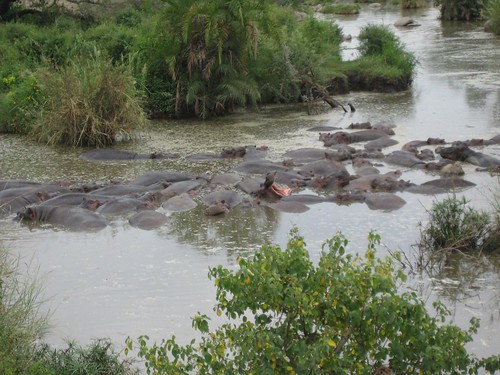 Hippos. We also saw one on land, though very far off. They are improbably fat and it’s hard to believe they can move as quickly as they do. But really, they looks exactly like they are supposed to.
Hippos. We also saw one on land, though very far off. They are improbably fat and it’s hard to believe they can move as quickly as they do. But really, they looks exactly like they are supposed to.
In fact, everything looked exactly like it was supposed to. It sounds stupid, but I kept thinking. “It all looks like ‘The Lion King’!” Take the warthogs – they really do trot along exactly like that, and when they’re alarmed their tails stick straight up in the air and trot a little faster. And hyenas really do have that hunchbacked sneaky look, and hippos really do open their mouth that wide.
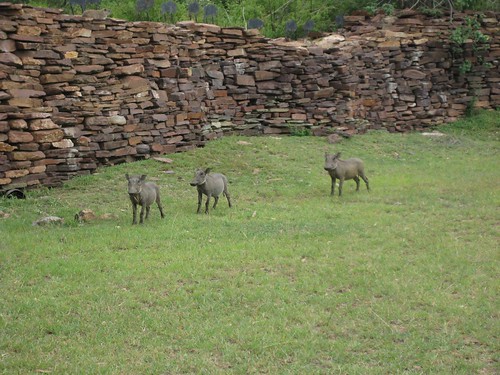 Baby warthogs, who were part of a family living, unwisely, under the entrance porch at the Serengeti Visitor’s Centre. There used to be four babies, but one got eaten by a lion a few days earlier.
Baby warthogs, who were part of a family living, unwisely, under the entrance porch at the Serengeti Visitor’s Centre. There used to be four babies, but one got eaten by a lion a few days earlier.There are approximately 3,876,320 different safari companies, all with the pop-top jeeps to cart tourists around, and the drivers all seem to be pretty friendly with one another. When we encountered another jeep, we’d almost always stop so the drivers could have a little conflab. I imagine they were letting each other in on where the good viewing was, because most people want to see the “Big Five” – lions, buffalo, elephants, leopard and rhinos. Word travels pretty quickly when there’s a good sighting, and there can literally be traffic jams when eight or ten or more jeeps all cram into a short section of road. It’s a bit weird.
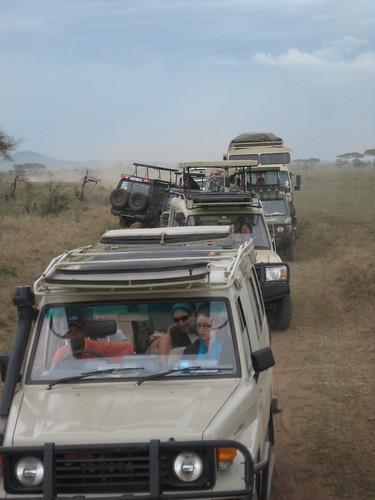 Traffic jam at a leopard sighting. No pics of the leopard because it and its baby were up in a tree and almost impossible to see, even with binoculars (or “nokkies” as the Australians in the group sometimes call them, because Aussies generally seem to be incapable of pronouncing all the syllables of most words)
Traffic jam at a leopard sighting. No pics of the leopard because it and its baby were up in a tree and almost impossible to see, even with binoculars (or “nokkies” as the Australians in the group sometimes call them, because Aussies generally seem to be incapable of pronouncing all the syllables of most words)
We had about two and a half days of game driving, some at Serengeti National Park (where we also camped for two nights), and some at the Ngororgoro crater, which is not really a crater at all, apparently, but in fact a “caldera”, whatever that is. Either way, it’s a pretty stunning view.
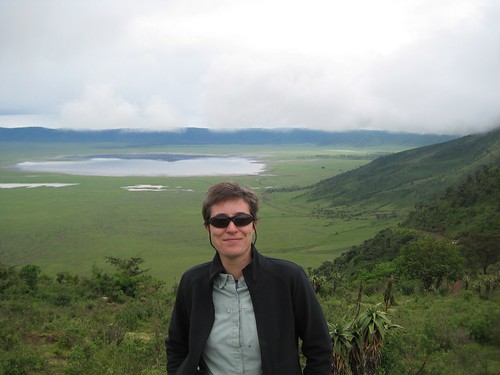 Me with the crater in the background. And no, I have not had a haircut. I decided to try growing it out, though I think that making that decision immediately before embarking on a 23-day camping trip might not have been smart. It would be much more practical to just shave my head. No promises on how long I’ll be able to hold out, because it already feels unbearably long, but I’ll give it a shot.
Me with the crater in the background. And no, I have not had a haircut. I decided to try growing it out, though I think that making that decision immediately before embarking on a 23-day camping trip might not have been smart. It would be much more practical to just shave my head. No promises on how long I’ll be able to hold out, because it already feels unbearably long, but I’ll give it a shot.
And other than the first night in Nairobi, we’ve been camping the whole way. We all pitch in setting up tents, hauling water, and helping to cook and clean, which is one of the reasons the Dragoman tours are so reasonably priced compared to more “full service” overland touring companies. I don’t have a problem with camping, and the Dragoman system seems to work reasonably well. For me, though, the whole thing breaks down when it starts raining, which it did very early on Christmas morning when we were camped in Serengeti National Park.
It really wasn’t the best Christmas morning. I slept fitfully and every time I woke, I could hear rain. Some people like the sound of rain on the roof of a tent when they are snug and dry inside. For me, it’s just a harbinger of what’s to come – a wet, muddy mess. Sure enough, I woke up at 5:30 am on the 25th and it was just miserable. Laurie tried to cheer me up by giving me a small present to open, which was sweet. Perhaps if it hadn’t been dark, AND raining, AND Christmas Day it might not have been so soul-destroying. As it was, we had a quick, damp, muddy breakfast, and struck our soggy tents and loaded up for the trip to Ngorogoro crater. We got away late, and then ended up later still because the previous night’s rains had overtopped a small bridge that was the only way in and out of the park. There was a big lineup of jeeps on either side, and lots of people milling around, checking things out.
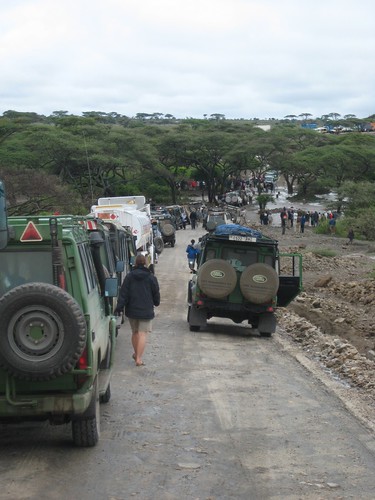 The lineup. Christmas Day, on the road in and out of the Serengeti.
The lineup. Christmas Day, on the road in and out of the Serengeti.
Really, though, all you could do was wait for the water to recede enough to pass. Because there was a lot of it.
 There’s a concrete bridge under there.
There’s a concrete bridge under there.
Luckily, we didn’t really have to wait long, though we heard that the first trucks in line waited for a couple of hours. In a way, it was quintessentially Africa – you really just have to go with the flow.
By the time we finally finished with the Ngoogoro crater and made it back to our campsite to be reunited with the truck, I was done with game driving. In fact, I was kind of just done in general. It was Christmas, and I was tired and dirty and I’d just finished setting up a soggy tent. I’d discovered that the text message Twitter updates I’d been sending hadn’t gone through, and I couldn’t get my cell phone to receive calls from Canada. And I was standing in a not-at-all-hot shower being cold and wet and listening to the rain outside and wondering why I was standing in the shower getting cold and wet when I was about to go outside and do the very same thing. And it was CHRISTMAS. The campground we were at actually had a lodge as well, and, like many of our stops, we were told we could upgrade to a room in the lodge when they were available. This upgrade would have cost $60 USD, and as I was standing in that shower I thought that sounded very very cheap indeed.
But then I dried off and we discovered that there was a space inside where we could have our Christmas dinner, and Laurie poured me a generous vodka and orange squosh and things seemed vaguely better. This is especially lucky, because it turns out there were no rooms available anyways. And really, it’s a good group of people, and there are enough of us that even if a few people are having a bad time of it, there are always other who are happy and cheerful and able to pull the others along until things get better.
So we had a nice evening, enjoying having a roof and walls while eating our Christmas dinner. And Dave and Sarah even gave us each a little Christmas package with some small treats and a Christmas cracker. And I played carols from the computer, and we drank and talked and laughed. I had a few minutes of credit on my phone to talk with people at home, and then Laurie and I retired to the tent and opened some little stocking stuffers my mom sent with her all the way from home. And it all seemed not so bad after all.
So that was Christmas on the Serengeti. I hope everyone had a nice holiday, and thanks for all the best wishes in comments and emails. I don’t have a lot of time to reply, because I’m trying to use my time online as efficiently as I can. So just know that your messages are getting through, and they are appreciated, and I’m doing fine and am among friends.

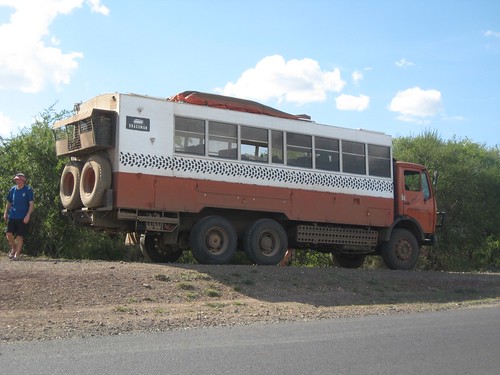
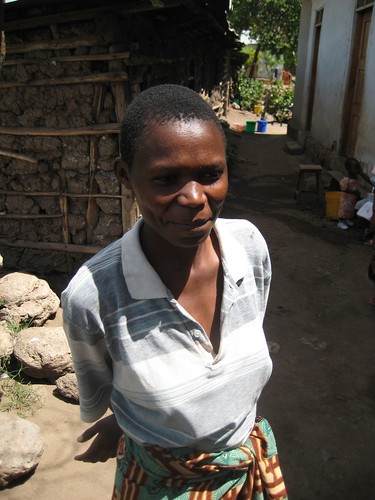 Here's the woman of the house - she made the beer!
Here's the woman of the house - she made the beer!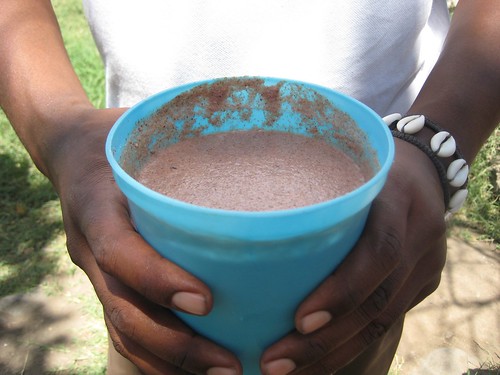
 Well how could I hold my head up at the next hash if I couldn't even chug a half a container of banana beer?
Well how could I hold my head up at the next hash if I couldn't even chug a half a container of banana beer?